By Karen Hock, a U of G student writer with SPARK (Students Promoting Awareness of Research Knowledge)

Heart failure affects more than the heart – it also impacts the respiratory system.
Heart disease is one of the leading causes of death worldwide, and understanding how heart failure affects different organs may help improve treatment options.
Andrew Foster, a PhD student in human health and nutritional sciences, says more than 500,000 Canadians are affected by heart failure caused by the impaired pumping of the heart and its inability to adequately meet oxygen demands of tissues. Symptoms include dyspnea (breathlessness) and the inability to exercise, which has prompted Foster, along with Prof. Jeremy Simpson in the Department of Human Health and Nutritional Sciences to explore how the respiratory system is involved.
“We need to focus on the respiratory component of heart failure as well,” says Foster. “It’s as important as the cardiac condition.”
As the heart gets bigger to adapt to increases in blood pressure (known as hypertension), heart enlargement, although beneficial initially, eventually leads to heart failure.
In the past, pulmonary edema – the accumulation of fluid in the lungs – was believed to be the cause of the respiratory effects seen in heart failure patients. However, says Foster, pulmonary edema occurs in less than half of patients, and is most commonly found in elderly patients at the end stages of heart failure.
He believes pulmonary edema may simply worsen the underlying respiratory condition in end-stage patients and may not be the primary cause.
Presently, no medications are available to prevent respiratory muscle dysfunction in patients with heart failure. Foster believes he may be able to develop a new treatment option that will improve respiratory function, leading to improved quality of life for many Canadians afflicted with the debilitating effects of heart failure.
Specifically, Foster is looking at the effects of heart failure on the diaphragm and lungs. Early on, muscle in the diaphragm atrophies, or wastes away. In the lungs, the small air sacs known as alveoli grow larger and tend to inflate less. Both of these structural changes are believed to contribute to the feeling of breathlessness.
Foster is interested in determining the mechanisms responsible for the respiratory dysfunction seen in heart failure patients. Along with M.Sc. student Alicia Arkell, he hopes to understand the effect of heart failure on the diaphragm and lungs in order to find new strategies to improve respiratory function in these patients.
To accomplish this goal, he is investigating the progression of heart failure in male mice. Once the mechanisms in mice are identified, they can be applied to humans as both species follow a similar progression of heart failure.
Foster became interested in heart failure during his undergrad at U of G. Although he has recently started his PhD, he hopes to continue his career in research, bridging the gap between animal and human studies. His research is supported by the Ontario Thoracic Society, the Natural Sciences and Engineering Research Council and the Canadian Institutes of Health Research.